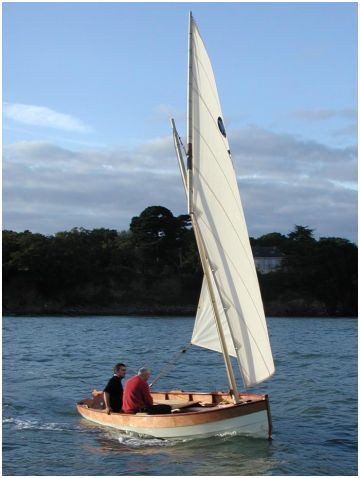
Sail and oars boats

 Before
modern times turned everything upside-down, all small boats, whether
used for fishing, as workboats, or for pleasure, were propelled by sail
or oar. In fact both coexisted, because a sailing vessel always needs a
means of propulsion when the wind fails, and no rowing boat, save in
restricted and sheltered water, will reject the help of the wind! Before
modern times turned everything upside-down, all small boats, whether
used for fishing, as workboats, or for pleasure, were propelled by sail
or oar. In fact both coexisted, because a sailing vessel always needs a
means of propulsion when the wind fails, and no rowing boat, save in
restricted and sheltered water, will reject the help of the wind!Gradually, in the course of the 20th century, traditional boats evolved. For fishing, the engine became king. Non-professionals chose "trolling", using sail and motor. Competitive sailors created the light centre-boarder, the racing keelboat and, later, the catamaran and sailboard. As for pure rowing, it gave birth to machines of no use to ordinary sailors. The common strand of all this evolution, in addition to the use of modern materials like polyester, is increasingly strong specialisation. Each kind of boat is designed for a specific use, whereas the traditional boat was, on the contrary, very general-purpose, while also offering extreme variety according to the local traditions and the sea and harbour conditions of its place of origin. It is in this context that a group of passionate sailors, linking the practice of sailing, curiosity about our maritime inheritance and a certain dissatisfaction about a pleasure which has become a mass leisure occupation, "invented" the voile-aviron (1). They also invented the principle of voile-aviron (2), meaning an alternative way of sailing, in boats which permit us to rediscover what modern sailing boats do not allow any more: to sail in an open boat in which the picnic basket happily finds a place, to discover the pleasure of rowing, silently, at sea or in a tidal river. The voile-aviron, even though it was inspired by tradition, can also fit into today’s society. Lighter, due to modern methods of construction which do not reject the use of wood, easy to transport by trailer and to launch, it is freed from harbour infrastructures and from the concreting of the littoral. Of small size, it lends itself particularly well to individual construction in a garage, and provides a marvellous way of using the talents of the handyman. In addition it has often been chosen by schools and other teaching establishments. From its first publication in 1981, the magazine Le Chasse-Marée has concentrated on the development of voile-aviron. At the end of 1981, I drew the Aven, the first voile-aviron of my series, 80 of which have been built by the “chantiers de Loctudy” (Jean de Massol workshop). In 1985 came the first building manual for the Aber, a boat specifically designed for home construction. Gradually other plans followed, meeting a wider range of boating needs. From 2000 the first kit-form boats (Laïta, Minahouet) have been available, using plywood components cut to shape on CNC machines to make construction much simpler. Now we reserve the term “voile-aviron” for boats in which the oar is a truly alternative mode of propulsion to the sail, and allowing us to avoid all motorisation. But one can sail in the same spirit with the boats that we class as “traditional pleasure-boats” or “classic sail boats”. The voiles-avirons now have a federation1, historically emerging from that of the Bantry Yoles, and an internet forum that I invite you to discover. (1) Here “voile-aviron” means “a sail-oar”, a boat designed to function well under both sail and oar. As far as I know, English has no equivalent term. Perhaps one should be invented. (2) Here “voile-aviron” means a particular boating philosophy, and we could use the term “sail and oar”. Translation by courtesy of Martin Corrick |